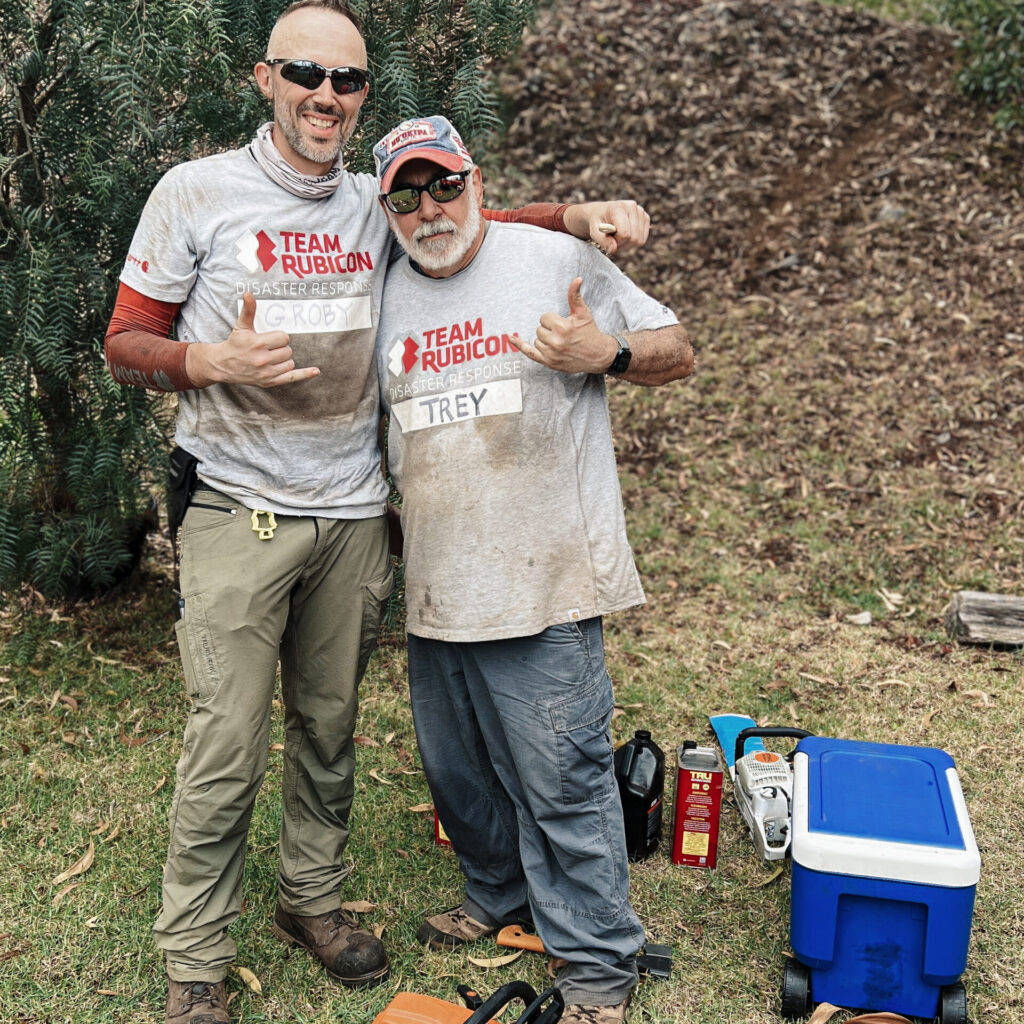I’m retired after 45 years of the military and work life. For the last several years, I have spent my days volunteering, including more recently serving as a volunteer in Maui. This includes being a trail steward at Haleakala National Park, beach cleaning for PacWhale Foundation, walking dogs for the Maui Humane Society, and doing groundskeeping at the Sugar Museum. I still volunteer for these groups, but now I’m also a Team Rubicon volunteer—or Greyshirt.
I had visited Lahaina the week before the Maui fires in August of 2023 and had traveled through Kula the day before the fires on my way to Haleakala National Park where I volunteer as a trail steward. Then, on the morning of the fires, I rode my bike to the Sugar Museum, which is located south of Kahului. On the way home, the wind was so strong that it almost knocked me off my bike.

That afternoon, news of the fires around the island was becoming known. In the evening, my daughter was evacuated from her home and, with a friend, came to stay at my home in Kihei. Soon, we received notice to prepare for evacuation. We packed our go bags as the skies turned a smokey red. Luckily, the fires stayed on the other side of the highway and we were spared the worst. But the following morning, we began to hear about the devastation in Lahaina and Kula. In many places, the fires continued to burn.
Maui is a close-knit community. It is half the size of Rhode Island and much of that is mountainous and uninhabited. While Maui is slightly larger than Oahu, Maui’s population is only about one-fifth of Oahu’s. It feels like everyone that you meet is connected to someone else that you know. More than 100 people died in the fire and thousands lost their homes. The majority of people who lost their homes are part of the most at-risk populations on Maui.
I wanted to be able to help those people and our community. The day after the fires hit Maui, I was looking on Facebook for ways to help. I donated money and goods, but I wanted to be able to help in a more direct and tangible way. One of the volunteer organizations mentioned online was Team Rubicon, and I signed up that day.
Almost immediately, Team Rubicon was involved in providing food and supplies at distribution centers in Kahului and Lahaina. When donated supplies needed to be moved from the Maui AIDS Foundation to Lahainaluna, we procured two vehicles and delivered the items to a distribution center on the edge of the burn scar. We next visited Lahaina and Kula to assess how Team Rubicon could assist.
After doing a recon, we determined that Kula would be best suited for Team Rubicon. I prepared a plan to hold a wildfire recovery and flood mitigation operation in this area. To prepare for the upcoming operation, we quickly held Sawyer and Site Survey training for Hawaiʻi-based members of Team Rubicon. We even spent a day doing olive picking for an organization that uses the olive oil proceeds to help troubled youth. Operation Olo Papa began on October 12th and continued until October 28th. Although I was new to Team Rubicon, I took on the role of Operations Section Chief. Each day, I was accountable for structuring the strike teams, determining their work assignments, and ensuring our efforts were successful. Later in the operation, I was also able to work in the field as a sawyer. More than 60 Greyshirts from the continent and across the islands participated in the 17-day operation.
In the year since the fires. I have taken on the role of Metro Admin for Maui. We recently supported Wreaths Across America Day, volunteered at Kipuka Olowalu, and are engaged in Maui’s long-term recovery efforts. We have a full slate of training and events for those who want to volunteer in Maui for the year ahead. We’re dedicated to doing our part to help Maui heal.

Trey Whitaker is a U.S. Army veteran who now serves as Team Rubicon’s metro admin, as well as a Greyshirt volunteer, in Maui.
Step Up to Volunteer in Maui
Want to assist with ongoing recovery and future fire mitigation work in Hawaiʻi? Become a Greyshirt now.



